Gloucestershire
GLOUCESTER
Gloucester is one of our historic cities trying to reconcile the heritage of the past with the demands of the present. Medieval buildings and modern shopping centres eye each other suspiciously. And not without reason; much of the ancient heart of the city has disappeared under twentieth century developments. At the centre, North-, South-, East- and Westgate Streets converge at a traffic-free crossroads, busy with shoppers and tourists by day. Close by are the historic New Inn, with its galleried courtyard where Shakespeare may have performed, and the little shop in College Court, which Beatrix Potter used as the model for the Tailor of Gloucester.
Gloucester's roll call of zealous and gifted men of faith is as great as any city of comparable size. It was the birthplace of the great evangelist George Whitefield (1714-1770), and in Queen Mary's reign the bishop, John Hooper (1495-1555), was one of the most radical Protestant reformers. He was burned at the stake in front of his cathedral. In the eighteenth century it was two Gloucester men,Thomas Stock (1749-1803) and Robert Raikes (1735-1811) who pioneered the Sunday School movement, which provided a moral and educational foundation for generations of children.
The Cathedral

Bishop Hooper memorial
The cathedral stands in College Green in the North West quarter of the city. It bears testimony to the genius of our medieval craftsmen, but for a full description the standard guides should be consulted. Sufficient here to note that the nave is largely Romanesque with massive round pillars while the choir and transepts show the emerging Perpendicular style, which became such a feature of late medieval architecture. In the cloisters we can see some of the finest fan vaulting in the world. The cathedral has also been used as the setting for Hogwarts School in the Harry Potter films
Just to the right of the South door is a memorial to Thomas Stock. He seems to have been a busy man for the inscription tells us that he was chief master of the College School, rector of St John's and perpetual curate of St Aldate's. To Stock, together with Robert Raikes, ....is justly attributed the honour of having planned and instituted the first Sunday School in the kingdom.
On June 20th 1736, George Whitefield knelt in the chancel to be ordained by Bishop Benson, but there is nothing to commemorate the occasion. A week later he preached his first sermon at St Mary de Crypt and within a few months his name was a household word across the land.
At the west end of College Green, St Mary's Gate leads out of the cathedral precincts to St Mary's Square. From the crooked windows above its pointed arch, friars watched as they brought the good Bishop Hooper on a February day in 1555 to suffer a martyr's death. An impressive memorial stands on the site close to the church of St Mary de Lode. Hooper's statue is covered by an ornate neo-gothic canopy, and carries the inscription Gloria Soli Deo. For the witness of Jesus and for the Word of God, not accepting deliverance, John Hooper D.D. Bishop of Gloucester and Worcester was burned to ashes on this spot February IX Anno Domini MDLV (GL1 2PG)
Bishop Hooper's Lodging

Bishop Hooper's Lodging
Standing opposite St Nicholas' Church in Westgate Street is an ancient house which now accommodates the Gloucester Life Museum (GL1 2PG). It is believed to be the house where Bishop Hooper was held for the night before his martyrdom. Most of the space is devoted to local crafts, including cheesemaking, eel and salmon fishing and pin making - once an important local industry. On the top floor is a display of items relating to Hooper. The most intriguing is the charred stump of a wooden post found in the churchyard of St Mary de Lode in 1826 and believed to the remains of the stake to which Hooper was tied. There is also a copy of Hooper's sermons on the book of Jonah and a small brass mace with the arms of Queen Mary and her husband Philip of Spain. This was probably carried by one of the guards bringing Hooper to Gloucester for execution.
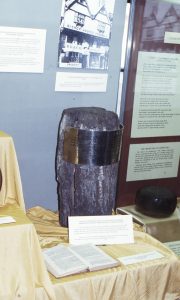
The charred stake
Hooper was born in Somerset and entered the Cistercian monastery at Cleeve. He studied at Oxford and in London and was influenced by the writings of the reformers Zwingli and Bullinger. Coming under suspicion for his opinions, he fled abroad in 1539 and spent nine years in France and Switzerland. With the accession of Edward VI, he returned to England and was consecrated Bishop of Gloucester in 1551, but on the succession of Edward's half-sister Mary, his reforming work was cut short and he was one of the first Protestant bishops to face arrest and trial.
St Mary de Crypt
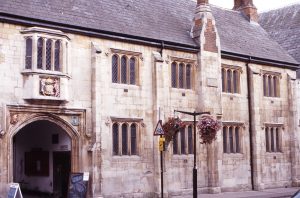
St Mary de Crypt
Facing directly on to Southgate Street, this was the parish church of George Whitefield - where he was baptised, went to school and preached his first sermon (GL1 2DR). It was also where his infant son was buried in 1744. Whitefield was born at the Bell Inn in Bell Lane, where his father was innkeeper [not the present Old Bell wine bar in Southgate Street which dates from about 1650]. It stood on the site of the Eastgate Street Shopping Centre but has long since disappeared.
When the church is locked, a key to the door in the archway is available at the Tourist Information Office across the road. We pass through the ancient schoolroom adjoining the church, which was once the Crypt School founded by John and Joanne Cooke in the sixteenth century. This was the first school attended by Whitefield. In 1880 the school moved, and this building was given to the church in commemoration of the centenary of Robert Raikes' first Sunday School. It continues to serve as the church hall.
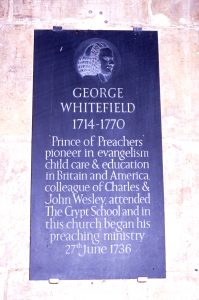
Whitefield memorial
The church itself is small and rectangular, without transepts. A leaflet guides us round, identifying features of interest. On the south side is the font, small like a birdbath, where both Whitefield and Raikes were baptised. The pulpit - used by Whitefield for his first sermon - has the original sounding board suspended above. The date was 27th June 1736, exactly a week after his ordination. A memorial tablet on the adjacent pillar commemorates Whitefield as pioneer in evangelism, child care and education in Britain and America.
The south-east corner of the church forms the Raikes Chapel, where Robert Raikes is buried in a family vault. There are various memorials to him and some framed facsimile copies of his letters.
Whitefield was one of the greatest preachers of all time. It was said that his unaided voice could be heard by crowds of 30,000 in the open air. He attended Pembroke College, Oxford, and was a member of the "Holy Club", founded by Charles Wesley. After ordination he served a brief curacy in Hampshire and then took to preaching in the open air. Whitefield made seven visits to America, preaching with such eloquence that even impressed sceptics like Benjamin Franklin. In the newly founded colony of Georgia he built an orphanage, whose financial and administrative needs proved a burden throughout his life. On 29th September 1770, he preached his final sermon at a house in Newburyport, Massachusetts, and died the following day.
Robert Raikes' House
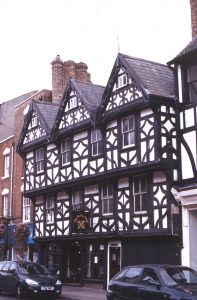
Robert Raikes house
The grand Elizabethan house just opposite St Mary de Crypt, now the Robert Raikes Inn, was the home of Robert Raikes from 1758 to 1801. It is in late Tudor style, with curving black-painted timbers, white plasterwork and three gables.
Raikes was a master printer and proprietor of the Gloucester Journal. He is generally credited with being the founder of Sunday Schools, in collaboration with Thomas Stock, rector of St John the Baptist. There are others with justifiable claims to precedence, but Raikes certainly did much to promote the movement. His first school began in a cottage in St Catherine's Street in 1780. Sunday Schools in the eighteenth century were not just about Bible teaching. Raikes and Stock aimed to provide basic primary education for the hordes of illiterate children employed in factories and shops, who tended to run wild and cause trouble on their only day of rest.
St John Northgate
The church of St John the Baptist was originally Anglican but since 1972 has been St John Northgate Methodist Church (GL1 2AN). It has a fourteenth century tower and spire but the main part of the building dates from 1732-34. Inside there is a tablet to Thomas Stock, the former rector, stating that he and Robert Raikes established and supported the four original Sunday Schools in this parish and St Catherine's. The east window is a centenary memorial to Stock. A plaque outside informs us that Methodism in Gloucester began on 15th July 1739 - with evangelistic meetings held by John Wesley - and records the various buildings used by the church.
Gloucester Park
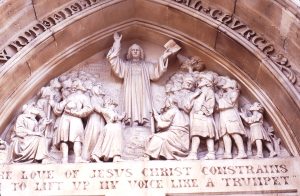
Whitefield Memorial Church
Close to the Park Road entrance is the bronze statue of Robert Raikes unveiled in 1930 to commemorate the 150th anniversary of the Sunday School movement. It show him book in hand, not unlike his statue on the Victoria Embankment in London, erected for the centenary.
On the corner of Belgrave Road and Park Road is the George Whitefield Memorial Church (GL1 1LS). Above the door is an interesting relief sculpture of Whitefield preaching to country folk in the open air, with a church symbolically in the background, its doors presumably closed to him.
KEBLE COUNTRY
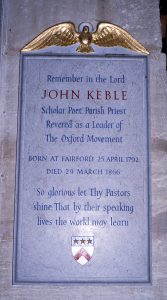
Keble memorial, Fairford
In the southeast corner of Gloucestershire between the rivers Coln and Leach is a little group of villages which seem to have taken a look at the twenty-first century and decided to ignore it. Many of them share memories of a pious and gentle soul who helped start a movement whose consequences he could scarcely have predicted. John Keble was born at Fairford in 1792, his father being vicar of nearby Coln St Aldwyns for over fifty years. St Mary's Church at Fairford (GL7 4AF) is unique in England in having a virtually complete set of 28 medieval stained glass windows, which have survived intact since before the Reformation. The only one missing is the west window which was blown out in a famous storm in 1703. There is memorial to Keble - scholar, poet, parish priest - in the choir, above some ancient choir stalls carved with intriguing misericords. His father is commemorated by a plaque in the sanctuary.
Keble won a scholarship to Corpus Christi College, Oxford, proved himself a brilliant student, and then returned to Fairford to help his father. From 1815 to 1818 he was curate of the parishes of Eastleach Turville and Eastleach Martin. The churches are only two hundred yards apart, separated by the river Leach - swift, clear and rich in flowers. The stone clapper bridge across it is known as Keble's Bridge, but looks as if it was here long before he was. The church at Eastleach Martin (GL7 3NH), no longer used for worship, has a memorial to Keble in the bell tower.
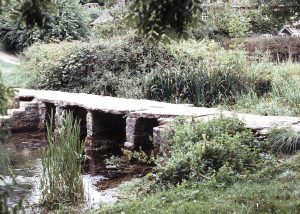
Keble's Bridge
For a time Keble was also curate of St Peter's church Southrop, a mile south of Eastleach and it was he who found the magnificent Norman font built into the south doorway. He lived in the vicarage, now called Southrop Lodge, opposite the Plough Inn, where his Oxford friends came and carried his gospel of high churchmanship back to the common room at Oriel College, where it took root in the hearts of John Henry Newman and Edward Pusey.
Keble returned to Oxford in 1831 as professor of poetry. His sermon on National Apostasy in 1833 caused a sensation and his poem The Christian Year enjoyed enormous popularity. But the Oxford Movement, which began as a defence of the principles of the Church of England, ended as a headlong flight from the doctrines of the Reformation, with many of its supporters joining the Roman Catholic church. Keble himself remained a loyal Anglican, and in 1836 accepted the living of Hursley in Hampshire, spending the rest of his life in blameless obscurity. He is remembered as the author of the well-known hymns New every morning is the love and Blessed are the pure in heart.
TRANSLATOR OF THE BIBLE
The great scholar, reformer and martyr William Tyndale (c1494-1536) was born somewhere along the Severn valley between Gloucester and Bristol, but no-one knows exactly where. North Nibley, Cam, Stinchcombe and Slimbridge all claim the honour.

Melksham Court
As if to bolster its rather slender claims, St John's Church (GL2 7BJ) at Slimbridge proclaims itself as "William Tyndale's church" and there is a wooden linenfold screen to his memory at the west end. The main evidence seems to be that one Edward Tyndale, probably a brother, lived at Hurst Farm in the parish and was buried here in 1546. If indeed young William was brought up here and taken to church each Sunday, the story has a bitter irony, for the vicar whose sermons he would have heard was none other than John Stokesley, later Bishop of London, a persecutor of Protestants and arch-enemy of the Reformation.
One local historian claims that Tyndale's birthplace was a splendid house, still privately owned, called Melksham Court at Stinchcombe It is in the upper part of the village and set well back from the road. It is known that Richard Tyndale, probably an elder brother, lived there in the first half of the sixteenth century.

Tyndale Monument, North Nibley
On a ridge above the village of North Nibley, Tyndale is commemorated by the William Tyndale Monument, visible for miles around (GL11 6DX). We reach it from a shady path climbing up a steep bank to the right. The monument is a square tapering column, surmounted by a gilded cross, with stairs inside leading up to an observation platform. There is an inscription to the man who first caused the new Testament to be printed in the mother tongue of his countrymen. Born near this spot, it adds vaguely, he suffered martyrdom at Vilvorde, Flanders on October 6th 1536.
Some time after the monument was erected in 1866 it was discovered that the William Tyndale of North Nibley, formerly thought to be the reformer, was still alive in 1542. No matter - we get a magnificent view of the Severn valley, including both suspension bridges, and covering most of the places with which Tyndale was associated.
Little Sodbury
William Tyndale left Gloucestershire in 1510 for Magdalen College Oxford. In 1515 he moved to Cambridge where he attended the lectures of Erasmus. He had already come under the influence of Luther's writings and by the time he returned to these parts in 1522 he was in most points a convinced Protestant. This time there is no doubt as to where he lived; it was at Little Sodbury Manor, a splendid gabled house where he was employed as tutor to the children of Sir John Walsh.
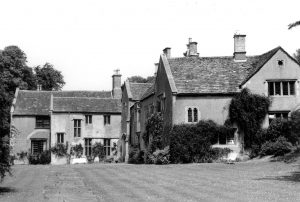
Little Sodbury Manor
The house is privately owned, set back from the road and screened by trees. It is not open to the public but group visits are occasionally arranged. It is believed that the main hall here was the scene of Tyndale's famous encounter with a visiting priest. If God spares my life he thundered I will cause the boy that driveth the plough to know more of scripture than thou knowest - prophetic words which were amply fulfilled over the next century. At the lower end of the village, the Tyndale Baptist Church keeps alive the memory of his sojourn in these parts.
Coming to London in 1524, Tyndale sought in vain for support in translating the Bible. He left for the Continent the same year, never to return. Moving from place to place to avoid Catholic opposition and King Henry's agents, he ministered to British merchants in Antwerp, conducted a spirited correspondence with Sir Thomas More and conferred with Luther and other reformers. Most important, aided by John Fryth and John Rogers, he translated the New Testament. Many of the phrases and expressions he used were adopted in later translations and have become part of our language.
WOTTON-UNDER-EDGE
The village lies amid rolling country between Stroud and Chipping Sodbury and in Tabernacle Road is the tabernacle built for Rowland Hill in 1771. Opposite is his Sunday School built in 1783. Born in 1744 to a distinguished Shropshire family, Hill was a popular preacher, who for fifty years spent six months of each year ministering here and the other six months at the Surrey Chapel in London.
The tabernacle, together with its former Sunday School across the road, is now an auction house; Hill's name can just be made out on the memorial plaque (GL12 7EB). Just below are some almshouses of the Rowland Hill Charity founded in 1815, although the present buildings date from 1877. Hill helped to found the London Missionary Society and one of its pioneers, Richard Knill, after labouring in India and Russia, returned to minister here for six years in the 1840s.
DEERHURST

Odda's Chapel
Lying beside the Severn a few miles south of Tewkesbury, it would seem that little has changed in this hamlet in a thousand years. It has barely a dozen buildings but two of them are among the oldest in England. Odda's Chapel, a late Saxon chapel dating from around 1056, has a simple nave and chancel. It was formerly used as the kitchen of an adjoining farmhouse called Abbots Croft and was only rediscovered in 1885.
The Priory Church of St Mary (GL19 7EB) was originally a monastery founded in the eighth century. Many original Saxon features can be seen, including herringbone brickwork in the outside walls, a curious two-light window high up in the west wall of the nave, and carved beasts on either side of the west door. The church also has the finest original Saxon font in England. A 10th century carved angel can be seen from the farmyard which, in Saxon style, buts up against the east wall of the church. The house adjacent to the church once formed part of the monastery cloisters.
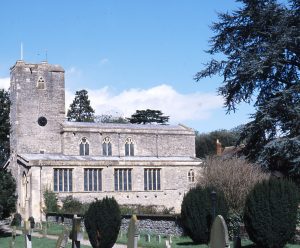
St Mary's, Deerhurst
In about 970, St Alphege (953-1012) came to Deerhurst to train for the monastic life. Expecting to find a devout and selfless community, he was shocked by the worldliness of his fellow monks and set about his own personal reformation. Alphege's life of self-denial and dedication shamed his companions into mending their ways and they began once again to take their vows seriously.
At a relatively young age, Alphege was appointed Abbot of Bath, then Bishop of Winchester and finally Archbishop of Canterbury in 1006. His period of office was marked by continued Danish incursions and he was much taken up with negotiations to mitigate their depredations. Kidnapped by the Vikings and held for ransom, he died a martyr's death at Greenwich, beaten to death with ox bones in a drunken orgy. He is commemorated by a stained glass window at the west end of the south aisle.
AUST
Lying under the shadow of the northern Severn bridge, this village may take its name from St Augustine of Canterbury. It is one of several places suggested for the location of a meeting between Augustine and the Welsh bishops in 603, but there is no conclusive evidence for this.
Bede records that the conference was arranged at a place called Augustine's Oak on the borders of the Hwiccii and the West Saxons. It was called to settle the question of whether the Celtic churches would submit to the authority of Augustine as archbishop of the English church, giving him the final word on matters of doctrine and practice. Uncertain about the doctrinal questions, the Welsh bishops, on the advice of a hermit, decided that they would judge the matter by whether or not Augustine rose to greet them when they arrived. Failing to show the required courtesy, Augustine remained seated and the conference ended in failure.


